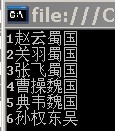IBatis.Net之多表查询:
一、定制实际对应类的方式
首先配置多表的测试数据库,IBatis.Net之Oracle表连接查询配置:
首先新建两张表如下:


为两张表建立外键:
ALTER TABLE Person ADD CONSTRAINT FK_COUNTRY_PERSON FOREIGN KEY(CountryId) REFERENCES Country(Id);
程序中,建立一个PersonCountry.xml
<?xml version="1.0" encoding="utf-8" ?> <sqlMap namespace="Ibatis" xmlns="http://ibatis.apache.org/mapping" xmlns:xls="http://www.w3.org/2001/XMLSchema-instance"> <resultMaps> <resultMap id="PersonCountry" Class="Ibatis.Net.Domain.PersonCountryModel"> <!--id会被statements节点所用,Class实体类所在位置--> <result property="Id" column="ID"/> <!--property实体类的属性名,column对应的列名--> <result property="Name" column="NAME"/> <result property="CountryName" column="COUNTRYNAME"/> </resultMap> </resultMaps> <statements> <select id="SelectAllPersonWithCountry" resultMap="PersonCountry"> SELECT p.Id,p.Name,c.CountryName FROM Person p INNER JOIN Country c ON p.CountryId = c.Id </select> </statements> </sqlMap>
再建立一个对应结果的Model类
namespace Ibatis.Net.Domain { public class PersonCountryModel { public int Id { get; set; } public string Name { get; set; } public string CountryName { get; set; } } }
建立一个Dao类:
public class PersonCountryDao { public IList<PersonCountryModel> GetList() { ISqlMapper mapper = Mapper.Instance(); IList<PersonCountryModel> ListPC = mapper.QueryForList<PersonCountryModel>("SelectAllPersonWithCountry", null); return ListPC; } }
执行代码:
static void Main(string[] args) { PersonCountryDao dao = new PersonCountryDao(); IList<PersonCountryModel> ListPC = dao.GetList(); foreach (PersonCountryModel p in ListPC) { Console.WriteLine(p.Id + p.Name + p.CountryName); } Console.ReadKey(); }
输出如下:

二、AS转换的方式
下面,我们还是用同样的例子。但是,这次我只想查Person.Id与CountryName。那么这次不用定制类的方式,应该怎样弄呢?
Person.xml如下:
<sqlMap namespace="Ibatis" xmlns="http://ibatis.apache.org/mapping" xmlns:xls="http://www.w3.org/2001/XMLSchema-instance"> <resultMaps> <resultMap id="Person" Class="Ibatis.Net.Domain.PersonModel"> <!--id会被statements节点所用,Class实体类所在位置--> <result property="Id" column="Id"/> <!--property实体类的属性名,column对应的列名--> <result property="Name" column="Name"/> </resultMap> </resultMaps> <statements> <select id="SelectPersonWithCountryName" ResultMap="Person"> SELECT Person.Id,CountryName AS Name FROM Person INNER JOIN Country ON Person.CountryId = Country.Id </select> </statements> </sqlMap>
注意此时的Person还是与Person表对应,只有两个字段,Id和Name,不用特别定制。
输出如下:

这里的例子较为简单,因为CountryName和Name都是字符串类型。如果复杂点,可能在写SQL语句的时候需要使用SQL函数转换类型,例如要查询的列是整型,但是能够接收返回结果的只有浮点型或字符串类型,这个时候就只有在SQL中转换类型了。但如果想查的是DateTime类型,能用于接收结果的属性只有int,那就没办法转了,只有定制对应类。
三、关联实体类
其实IBatis.net也支持NHibernate的那种方式,实体类关联的方式来支持表与表之间的关系:
如,这次我想查询Person,Country所有的信息:
public class PersonModel { public int Id { get; set; } public string Name { get; set; } //在Person之中加入一个CountryModel public CountryModel Country { get; set; } }
配置文件:
<sqlMap namespace="Ibatis" xmlns="http://ibatis.apache.org/mapping" xmlns:xls="http://www.w3.org/2001/XMLSchema-instance"> <resultMaps> <resultMap id="Person" Class="Ibatis.Net.Domain.PersonModel"> <result property="Id" column="Id"/> <result property="Name" column="Name"/> <result property="Country" resultMapping="Ibatis.Country"/><!--Ibatis是关联类所在xml文件的namespace,Country是下两行的那个id--> </resultMap> <resultMap id="Country" Class="Ibatis.Net.Domain.CountryModel"> <result property="Id" column="Id"/> <result property="CountryName" column="CountryName"/> </resultMap> </resultMaps> <statements> <select id="SelectPersonWithCountryName" resultMap="Person"> SELECT * FROM Person INNER JOIN Country ON Person.CountryId = Country.Id </select> </statements> </sqlMap>
运行输出如下:

原文地址:http://www.cnblogs.com/kissdodog/p/3302619.html